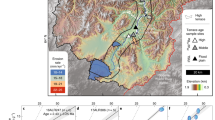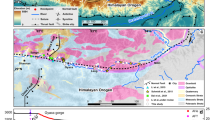Abstract
The onset of rapid exhumation along the high relief margins of orogenic plateaux is often used as a proxy for the timing of surface uplift1,2,3. However, processes that inhibit incision by rivers, such as spatially variable rock uplift4, orographic changes in rainfall5 and channel damming by glaciers or landslides6,7 may lead to exhumation that significantly lags surface uplift8. Here we reconstruct the timing, rate and pattern of fluvial incision along the Yellow River in northeastern Tibet using stratigraphic, geochronologic and geomorphic data from sedimentary basins along the present-day river course. We find that the onset of fluvial incision occurred substantially later than the onset of mountain building, 14–8 million years (Myr) ago9. Fluvial incision initiated at the plateau margin 1.8 Myr ago10 and progressed upstream11 at a rate of approximately 350 km Myr−1. We conclude that the fluvial incision was a result of a climatically driven expansion of lake systems in the region12,13 that led to lake spillover and consequently the integration of the modern Yellow River.
This is a preview of subscription content, access via your institution
Access options
Subscribe to this journal
Receive 12 print issues and online access
$259.00 per year
only $21.58 per issue
Buy this article
- Purchase on Springer Link
- Instant access to full article PDF
Prices may be subject to local taxes which are calculated during checkout




Similar content being viewed by others
References
Kirby, E. et al. Late Cenozoic evolution of the eastern margin of the Tibetan Plateau: Inferences from 40Ar/39Ar and (U–Th)/He thermochronology. Tectonics 21, 1–20 (2002).
Clark, M. K. et al. Late Cenozoic uplift of southeastern Tibet. Geology 33, 525–528 (2005).
Schoenbohm, L. M., Whipple, K. X., Burchfiel, B. C. & Chen, L. Geomorphic constraints on surface uplift, exhumation, and plateau growth in the Red River region, Yunnan Province, China. Geol. Soc. Am. Bull. 116, 895–909 (2004).
Zeitler, P. K. et al. Erosion, Himalayan geodynamics, and the geomorphology of metamorphism. Geol. Soc. Am. Today 11, 4–9 (2001).
Sobel, E. R., Hilley, G. E. & Strecker, M. Formation of internally drained contractional basins by aridity-limited bedrock incision. J. Geophys. Res. 108, 1–23 (2003).
Ouimet, W. B., Whipple, K. X., Royden, L. H., Sun, Z. & Chen, Z. The influence of large landslides on river incision in a transient landscape: Eastern margin of the Tibetan Plateau (Sichuan, China). Geol. Soc. Am. Bull. 119, 1462–1476 (2007).
Korup, O. & Montgomery, D. R. Tibetan plateau river incision inhibited by glacial stabilization of the Tsangpo gorge. Nature 455, 786–789 (2008).
van der Beek, P. et al. Eocene Tibetan plateau remnants preserved in the northwest Himalaya. Nature Geosci. 2, 364–368 (2009).
Lease, R. O., Burbank, D. W., Gehrels, G., Wang, Z. & Yuan, D. Signatures of mountain building: Detrital zircon U/Pb ages from northeastern Tibet. Geology 35, 239–242 (2007).
Li, J. J. et al. Magnetostratigraphic dating of river terraces: Rapid and intermittent incision by the Yellow River of the northeastern margin of the Tibetan Plateau during the Quaternary. J. Geophys. Res. B 102, 10121–10132 (1997).
Harkins, N., Kirby, E., Heimsath, A., Robinson, R. & Reiser, U. Transient fluvial incision in the headwaters of the Yellow River, northeastern Tibet, China. J. Geophys. Res. 112, F03S04 (2007).
Fang, X., Garzione, C. N., Van der Voo, R., Li, J. & Fan, M. Flexural subsidence by 29 Ma on the NE edge of Tibet from magnetostratigraphy of Linxia Basin, China. Earth Planet. Sci. Lett. 210, 545–560 (2003).
Wu, F. et al. Plio-Quaternary stepwise drying of Asia: Evidence from a ∼3-Ma pollen record from the Chinese Loess Plateau. Earth Planet. Sci. Lett. 257, 160–169 (2007).
Horton, B. K. et al. Mesozoic–Cenozoic evolution of the Xining-Minhe and Dangchang Basins, northeastern Tibetan Plateau: Magnetostratigraphic and biostratigraphic results. J. Geophys. Res. 109, B04402 (2004).
Garzione, C. N., Ikari, M. J. & Basu, A. Source of Oligocene to Pliocene sedimentary rocks in the Linxia basin in northeastern Tibet from Nd isotopes: Implications for tectonic forcing of climate. Geol. Soc. Am. Bull. 117, 1156–1166 (2005).
Dettman, D. L., Fang, X., Garzione, C. N. & Li, J. Uplift-driven climate change at 12 Ma: A long δ18O record from the NE margin of the Tibetan Plateau. Earth Planet. Sci. Lett. 214, 267–277 (2003).
Zheng, D. et al. Rapid exhumation at ∼8 Ma on the Liupan Shan thrust fault from apatite fission-track thermochronology: Implications for growth of the northeastern Tibetan Plateau margin. Earth Planet. Sci. Lett. 248, 198–208 (2006).
Métivier, F., Gaudemer, Y., Tapponnier, P. & Meyer, B. Northeastward growth of the Tibet plateau deduced from balanced reconstruction of two depositional areas: The Qaidam and Hexi Corridor basins, China. Tectonics 17, 823–842 (1998).
Fang, X. et al. Late Cenozoic deformation and uplift of the NE Tibetan Plateau: Evidence from high-resolution magnetostratigraphy of the Guide Basin, Qinghai Province, China. Geol. Soc. Am. Bull. 117, 1208–1225 (2005).
Zhu, J. et al. Study on the Evolution, Environmental Change and Ecosystem of the Qingahi Xizang Plateau [in Chinese] (eds Expert Committee for Qingzang Program) 77–90 (Science Press, 1995).
Li, J. The environmental effects of the uplift of the Qinghai–Xizang Plateau. Quat. Sci. Rev. 10, 479–483 (1991).
Pan, B., Li, J., Cao, J. & Chen, F. Study on the geomorphic evolution and development of the Yellow River in the Hualong Basin [in Chinese]. Mountain Res. 14, 153–158 (1996).
Zeng, Y., Ma, H., Li, Z. & Li, L. A study on terrace formation and development of the Huangshui River in Xining Area [in Chinese]. Sci. Geogr. Sin. 15, 253–259 (1995).
Zheng, S. H., Wu, W. Y., Li, Y. & Wang, G. D. Late Cenozoic mammalian faunas of Guide and Gonghe basins, Qinghai Province (trans. Downs, W.). Vertabr. Palasiat. 23, 89–134 (1985).
Granger, D. E. & Muzikar, P. F. Dating sediment burial with in situ-produced cosmogenic nuclides: Theory, techniques, and limitations. Earth Planet. Sci. Lett. 188, 269–281 (2001).
Granger, D. E. in In situ-Produced Cosmogenic Nuclides and Quantification of Geological Processes (eds Siame, L. L., Bourles, D. L. & Brown, E. T.) 1–16 (Special Paper Vol. 415, Geological Society of America, 2006).
Wegmann, K. W. & Pazzaglia, F. J. Holocene strath terraces, climate change, and active tectonics: The Clearwater River basin, Olympic Peninsula, Washington State. Geol. Soc. Am. Bull. 114, 731–744 (2002).
Sobel, E. R., Hilley, G. E. & Strecker, M. Formation of internally drained contractional basins by aridity-limited bedrock incision. J. Geophys. Res. 108, 1–23 (2003).
Molnar, P. Late Cenozoic increase in accumulation rates of terrestrial sediment: How might climate change have affected erosion rates? Annu. Rev. Earth Planet. Sci. 32, 67–89 (2004).
Ogg, J. G. & Smith, A. G. in A Geologic Time Scale (eds Gradstein, F. M., Ogg, J. G. & Smith, A. G.) (Cambridge Univ. Press, 2004).
Acknowledgements
This research was supported by the Continental Dynamics programme at NSF (EAR-0506622). We thank L. Qiang, of the Institute of Vertebrate Paleontology and Paleoanthropology in Beijing, and W. Xiaoming, of the Los Angeles Museum of Natural History, for assistance with fossil identification. T. Raub provided guidance in the Caltech Paleomagnetics Laboratory, R. Lease helped with palaeomagnetic data and M. Rogers assisted in the field. Thoughtful reviews by D. Montgomery and O. Korup improved the manuscript.
Author information
Authors and Affiliations
Contributions
All authors conducted field work; E.K., W.H.C. and N.W.H. contributed to the experimental design and writing of this manuscript; W.H.C. and N.W.H. carried out burial age calculations; W.H.C. analysed palaeomagnetic samples and conducted volumetric denudation analyses.
Corresponding authors
Ethics declarations
Competing interests
The authors declare no competing financial interests.
Supplementary information
Supplementary Information
Supplementary Information (PDF 1169 kb)
Rights and permissions
About this article
Cite this article
Craddock, W., Kirby, E., Harkins, N. et al. Rapid fluvial incision along the Yellow River during headward basin integration. Nature Geosci 3, 209–213 (2010). https://doi.org/10.1038/ngeo777
Received:
Accepted:
Published:
Issue Date:
DOI: https://doi.org/10.1038/ngeo777
This article is cited by
-
Tectonic and climatic controls for fluvial terraces of the Yellow River over the past 2.6 Ma at Northeast Tibetan Plateau and Ordos Block
Journal of Mountain Science (2023)
-
Research on geological and surfacial processes and major disaster effects in the Yellow River Basin
Science China Earth Sciences (2022)
-
Pottery circulation and cultural exchange during the mid-late Neolithic Age in the northeastern Tibetan Plateau
Archaeological and Anthropological Sciences (2022)
-
Poleward and weakened westerlies during Pliocene warmth
Nature (2021)
-
Radiogenic heat production of crystalline rocks in the Gonghe Basin Complex (northeastern Qinghai–Tibet plateau, China)
Environmental Earth Sciences (2021)



